Economics for Business: Monopoly vs. Monopolistic Competition in AU
VerifiedAdded on 2023/06/07
|11
|2856
|104
Essay
AI Summary
This essay provides a detailed analysis of monopoly and monopolistically competitive market structures in Australia, using the Australian postal service and coffee industry as examples. It discusses the characteristics of each market structure, including the role of government intervention in regulating monopolies and promoting competition. The essay explores how the Australian government implements policies to protect consumer interests and ensure efficient resource allocation within these markets. It highlights the differences in market power and competitive dynamics between the two structures, concluding that government intervention is more critical in monopoly markets due to the potential for exploitation and reduced consumer surplus, while monopolistically competitive markets benefit from inherent competition.
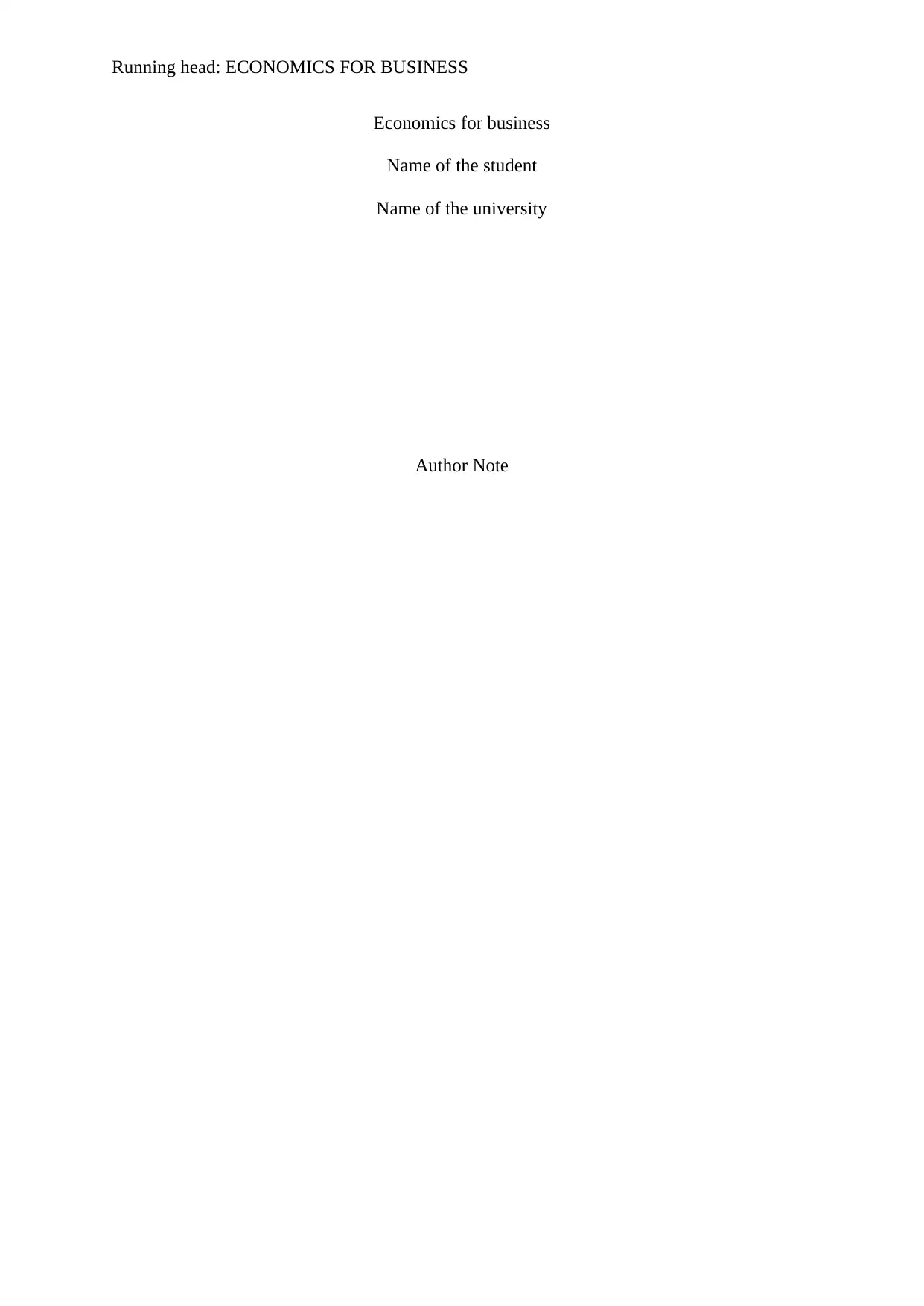
Running head: ECONOMICS FOR BUSINESS
Economics for business
Name of the student
Name of the university
Author Note
Economics for business
Name of the student
Name of the university
Author Note
Paraphrase This Document
Need a fresh take? Get an instant paraphrase of this document with our AI Paraphraser
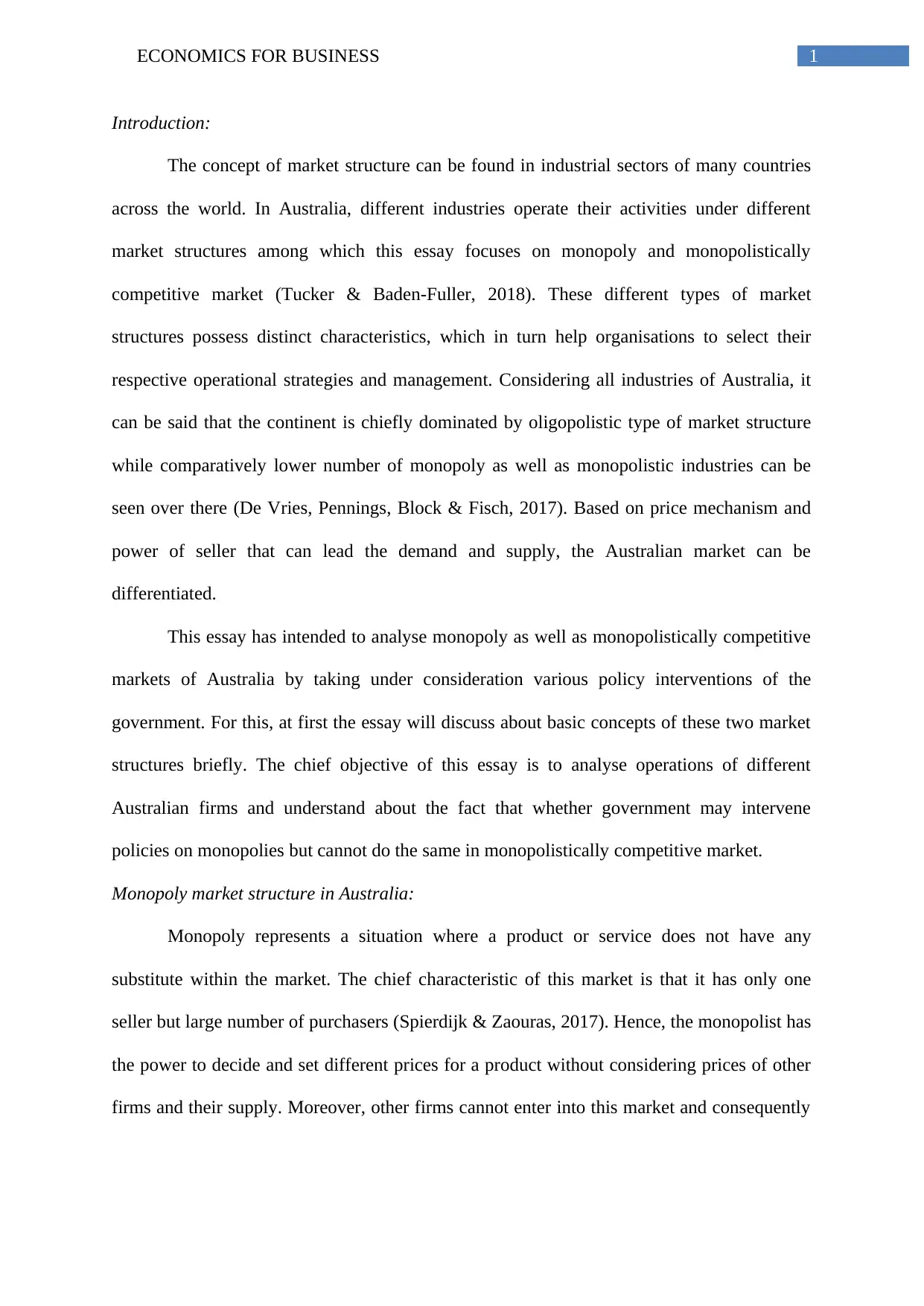
1ECONOMICS FOR BUSINESS
Introduction:
The concept of market structure can be found in industrial sectors of many countries
across the world. In Australia, different industries operate their activities under different
market structures among which this essay focuses on monopoly and monopolistically
competitive market (Tucker & Baden-Fuller, 2018). These different types of market
structures possess distinct characteristics, which in turn help organisations to select their
respective operational strategies and management. Considering all industries of Australia, it
can be said that the continent is chiefly dominated by oligopolistic type of market structure
while comparatively lower number of monopoly as well as monopolistic industries can be
seen over there (De Vries, Pennings, Block & Fisch, 2017). Based on price mechanism and
power of seller that can lead the demand and supply, the Australian market can be
differentiated.
This essay has intended to analyse monopoly as well as monopolistically competitive
markets of Australia by taking under consideration various policy interventions of the
government. For this, at first the essay will discuss about basic concepts of these two market
structures briefly. The chief objective of this essay is to analyse operations of different
Australian firms and understand about the fact that whether government may intervene
policies on monopolies but cannot do the same in monopolistically competitive market.
Monopoly market structure in Australia:
Monopoly represents a situation where a product or service does not have any
substitute within the market. The chief characteristic of this market is that it has only one
seller but large number of purchasers (Spierdijk & Zaouras, 2017). Hence, the monopolist has
the power to decide and set different prices for a product without considering prices of other
firms and their supply. Moreover, other firms cannot enter into this market and consequently
Introduction:
The concept of market structure can be found in industrial sectors of many countries
across the world. In Australia, different industries operate their activities under different
market structures among which this essay focuses on monopoly and monopolistically
competitive market (Tucker & Baden-Fuller, 2018). These different types of market
structures possess distinct characteristics, which in turn help organisations to select their
respective operational strategies and management. Considering all industries of Australia, it
can be said that the continent is chiefly dominated by oligopolistic type of market structure
while comparatively lower number of monopoly as well as monopolistic industries can be
seen over there (De Vries, Pennings, Block & Fisch, 2017). Based on price mechanism and
power of seller that can lead the demand and supply, the Australian market can be
differentiated.
This essay has intended to analyse monopoly as well as monopolistically competitive
markets of Australia by taking under consideration various policy interventions of the
government. For this, at first the essay will discuss about basic concepts of these two market
structures briefly. The chief objective of this essay is to analyse operations of different
Australian firms and understand about the fact that whether government may intervene
policies on monopolies but cannot do the same in monopolistically competitive market.
Monopoly market structure in Australia:
Monopoly represents a situation where a product or service does not have any
substitute within the market. The chief characteristic of this market is that it has only one
seller but large number of purchasers (Spierdijk & Zaouras, 2017). Hence, the monopolist has
the power to decide and set different prices for a product without considering prices of other
firms and their supply. Moreover, other firms cannot enter into this market and consequently
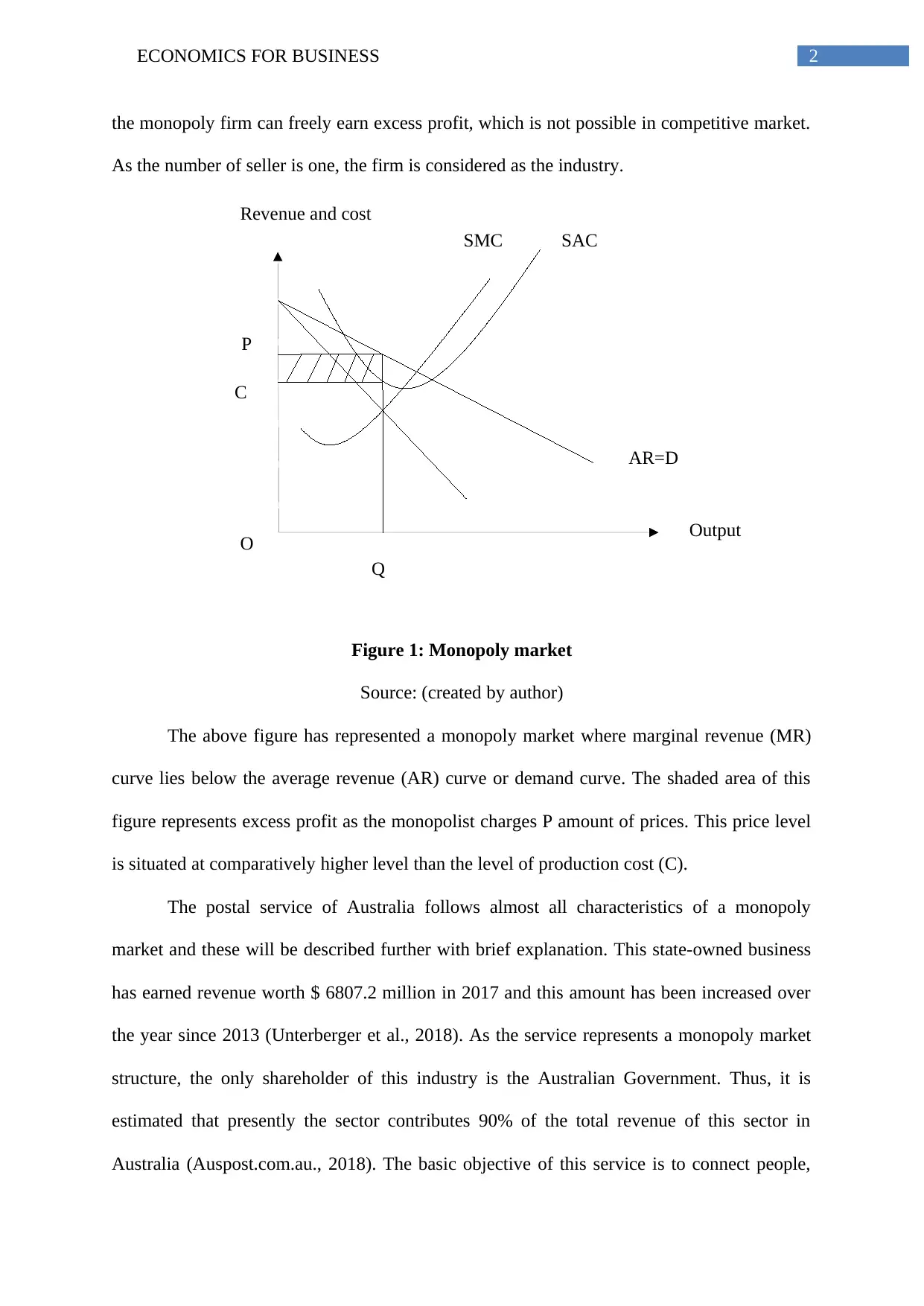
2ECONOMICS FOR BUSINESS
P
Revenue and cost
Output
O
Q
SACSMC
AR=D
C
the monopoly firm can freely earn excess profit, which is not possible in competitive market.
As the number of seller is one, the firm is considered as the industry.
Figure 1: Monopoly market
Source: (created by author)
The above figure has represented a monopoly market where marginal revenue (MR)
curve lies below the average revenue (AR) curve or demand curve. The shaded area of this
figure represents excess profit as the monopolist charges P amount of prices. This price level
is situated at comparatively higher level than the level of production cost (C).
The postal service of Australia follows almost all characteristics of a monopoly
market and these will be described further with brief explanation. This state-owned business
has earned revenue worth $ 6807.2 million in 2017 and this amount has been increased over
the year since 2013 (Unterberger et al., 2018). As the service represents a monopoly market
structure, the only shareholder of this industry is the Australian Government. Thus, it is
estimated that presently the sector contributes 90% of the total revenue of this sector in
Australia (Auspost.com.au., 2018). The basic objective of this service is to connect people,
P
Revenue and cost
Output
O
Q
SACSMC
AR=D
C
the monopoly firm can freely earn excess profit, which is not possible in competitive market.
As the number of seller is one, the firm is considered as the industry.
Figure 1: Monopoly market
Source: (created by author)
The above figure has represented a monopoly market where marginal revenue (MR)
curve lies below the average revenue (AR) curve or demand curve. The shaded area of this
figure represents excess profit as the monopolist charges P amount of prices. This price level
is situated at comparatively higher level than the level of production cost (C).
The postal service of Australia follows almost all characteristics of a monopoly
market and these will be described further with brief explanation. This state-owned business
has earned revenue worth $ 6807.2 million in 2017 and this amount has been increased over
the year since 2013 (Unterberger et al., 2018). As the service represents a monopoly market
structure, the only shareholder of this industry is the Australian Government. Thus, it is
estimated that presently the sector contributes 90% of the total revenue of this sector in
Australia (Auspost.com.au., 2018). The basic objective of this service is to connect people,
⊘ This is a preview!⊘
Do you want full access?
Subscribe today to unlock all pages.

Trusted by 1+ million students worldwide
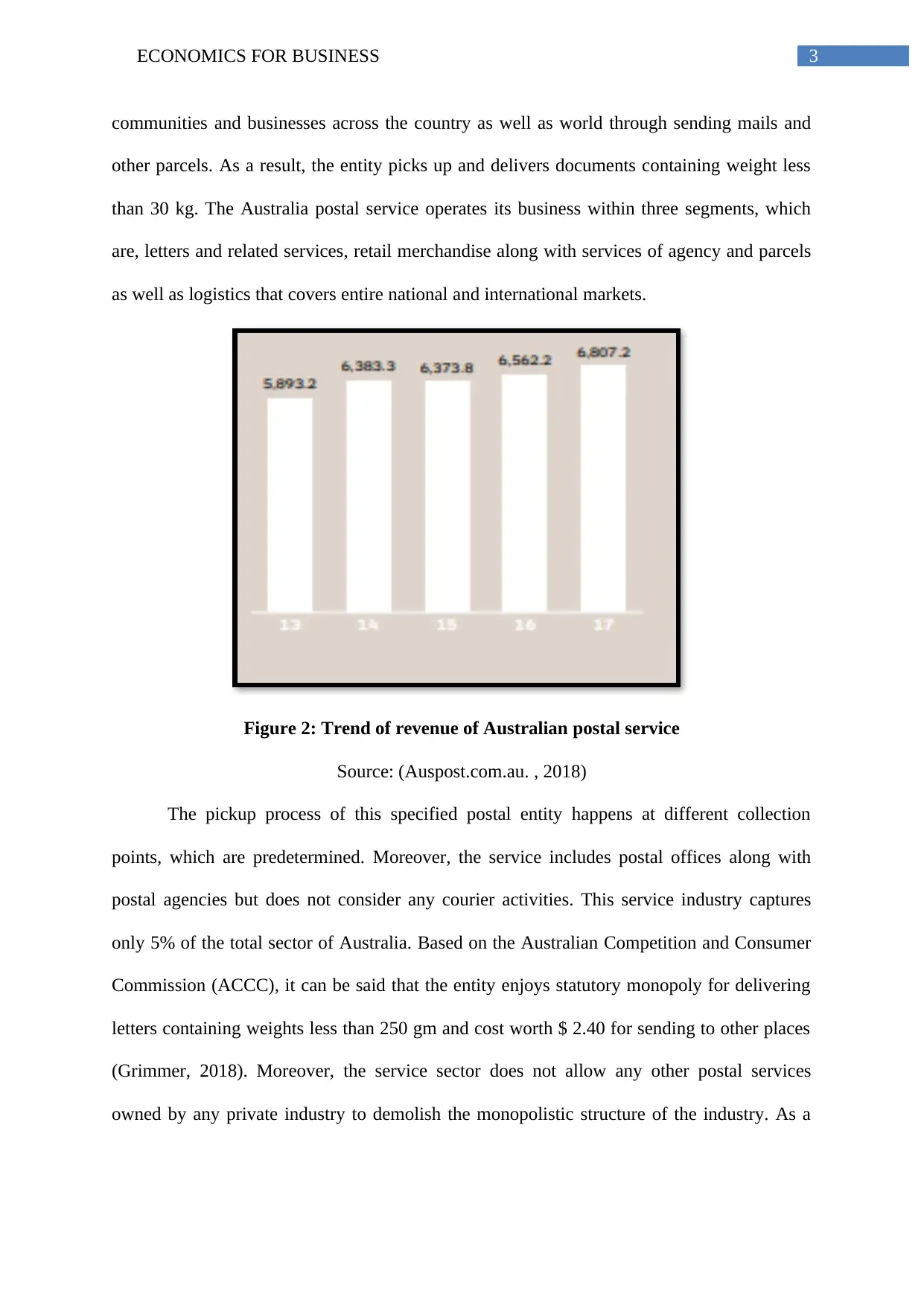
3ECONOMICS FOR BUSINESS
communities and businesses across the country as well as world through sending mails and
other parcels. As a result, the entity picks up and delivers documents containing weight less
than 30 kg. The Australia postal service operates its business within three segments, which
are, letters and related services, retail merchandise along with services of agency and parcels
as well as logistics that covers entire national and international markets.
Figure 2: Trend of revenue of Australian postal service
Source: (Auspost.com.au. , 2018)
The pickup process of this specified postal entity happens at different collection
points, which are predetermined. Moreover, the service includes postal offices along with
postal agencies but does not consider any courier activities. This service industry captures
only 5% of the total sector of Australia. Based on the Australian Competition and Consumer
Commission (ACCC), it can be said that the entity enjoys statutory monopoly for delivering
letters containing weights less than 250 gm and cost worth $ 2.40 for sending to other places
(Grimmer, 2018). Moreover, the service sector does not allow any other postal services
owned by any private industry to demolish the monopolistic structure of the industry. As a
communities and businesses across the country as well as world through sending mails and
other parcels. As a result, the entity picks up and delivers documents containing weight less
than 30 kg. The Australia postal service operates its business within three segments, which
are, letters and related services, retail merchandise along with services of agency and parcels
as well as logistics that covers entire national and international markets.
Figure 2: Trend of revenue of Australian postal service
Source: (Auspost.com.au. , 2018)
The pickup process of this specified postal entity happens at different collection
points, which are predetermined. Moreover, the service includes postal offices along with
postal agencies but does not consider any courier activities. This service industry captures
only 5% of the total sector of Australia. Based on the Australian Competition and Consumer
Commission (ACCC), it can be said that the entity enjoys statutory monopoly for delivering
letters containing weights less than 250 gm and cost worth $ 2.40 for sending to other places
(Grimmer, 2018). Moreover, the service sector does not allow any other postal services
owned by any private industry to demolish the monopolistic structure of the industry. As a
Paraphrase This Document
Need a fresh take? Get an instant paraphrase of this document with our AI Paraphraser
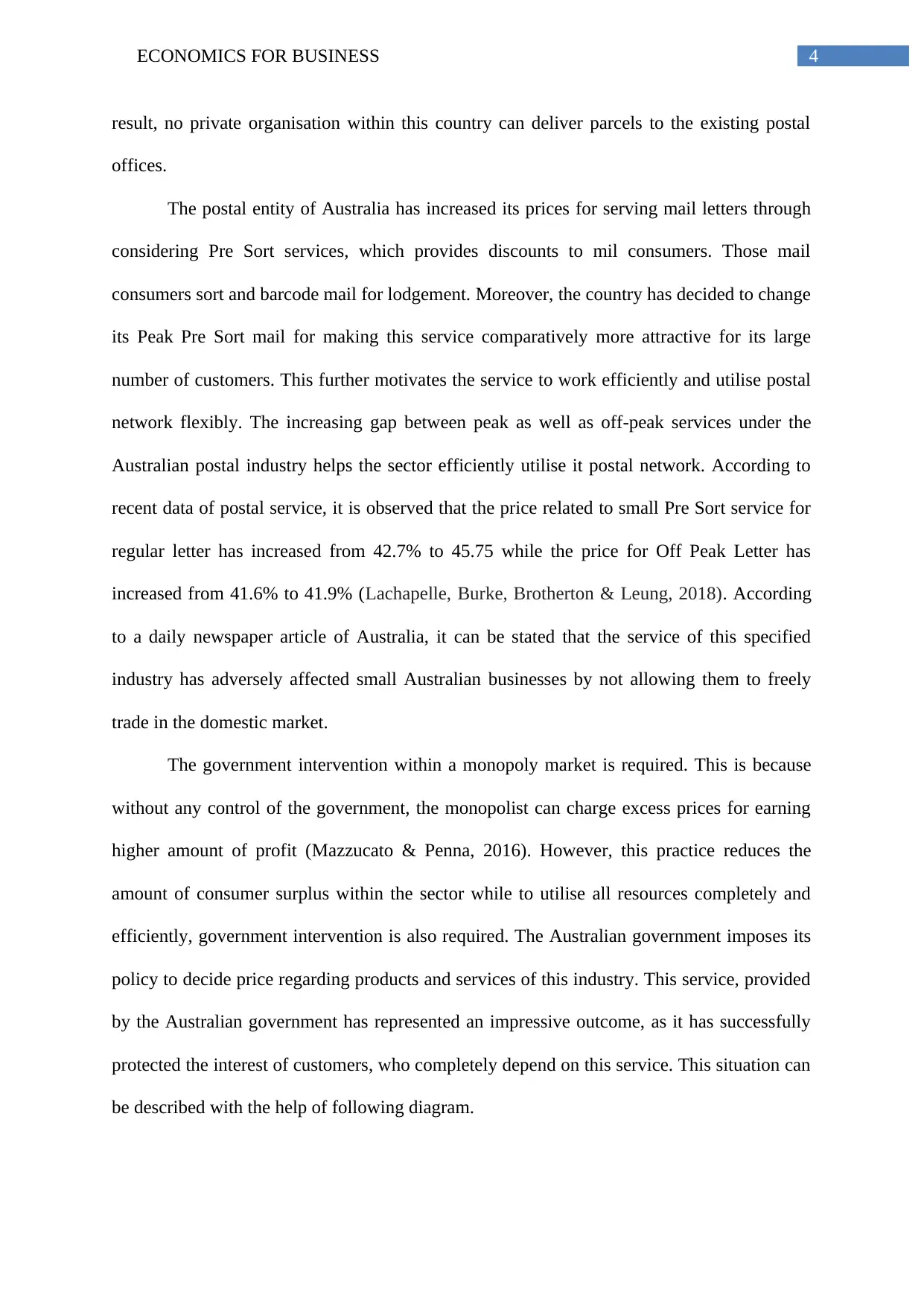
4ECONOMICS FOR BUSINESS
result, no private organisation within this country can deliver parcels to the existing postal
offices.
The postal entity of Australia has increased its prices for serving mail letters through
considering Pre Sort services, which provides discounts to mil consumers. Those mail
consumers sort and barcode mail for lodgement. Moreover, the country has decided to change
its Peak Pre Sort mail for making this service comparatively more attractive for its large
number of customers. This further motivates the service to work efficiently and utilise postal
network flexibly. The increasing gap between peak as well as off-peak services under the
Australian postal industry helps the sector efficiently utilise it postal network. According to
recent data of postal service, it is observed that the price related to small Pre Sort service for
regular letter has increased from 42.7% to 45.75 while the price for Off Peak Letter has
increased from 41.6% to 41.9% (Lachapelle, Burke, Brotherton & Leung, 2018). According
to a daily newspaper article of Australia, it can be stated that the service of this specified
industry has adversely affected small Australian businesses by not allowing them to freely
trade in the domestic market.
The government intervention within a monopoly market is required. This is because
without any control of the government, the monopolist can charge excess prices for earning
higher amount of profit (Mazzucato & Penna, 2016). However, this practice reduces the
amount of consumer surplus within the sector while to utilise all resources completely and
efficiently, government intervention is also required. The Australian government imposes its
policy to decide price regarding products and services of this industry. This service, provided
by the Australian government has represented an impressive outcome, as it has successfully
protected the interest of customers, who completely depend on this service. This situation can
be described with the help of following diagram.
result, no private organisation within this country can deliver parcels to the existing postal
offices.
The postal entity of Australia has increased its prices for serving mail letters through
considering Pre Sort services, which provides discounts to mil consumers. Those mail
consumers sort and barcode mail for lodgement. Moreover, the country has decided to change
its Peak Pre Sort mail for making this service comparatively more attractive for its large
number of customers. This further motivates the service to work efficiently and utilise postal
network flexibly. The increasing gap between peak as well as off-peak services under the
Australian postal industry helps the sector efficiently utilise it postal network. According to
recent data of postal service, it is observed that the price related to small Pre Sort service for
regular letter has increased from 42.7% to 45.75 while the price for Off Peak Letter has
increased from 41.6% to 41.9% (Lachapelle, Burke, Brotherton & Leung, 2018). According
to a daily newspaper article of Australia, it can be stated that the service of this specified
industry has adversely affected small Australian businesses by not allowing them to freely
trade in the domestic market.
The government intervention within a monopoly market is required. This is because
without any control of the government, the monopolist can charge excess prices for earning
higher amount of profit (Mazzucato & Penna, 2016). However, this practice reduces the
amount of consumer surplus within the sector while to utilise all resources completely and
efficiently, government intervention is also required. The Australian government imposes its
policy to decide price regarding products and services of this industry. This service, provided
by the Australian government has represented an impressive outcome, as it has successfully
protected the interest of customers, who completely depend on this service. This situation can
be described with the help of following diagram.
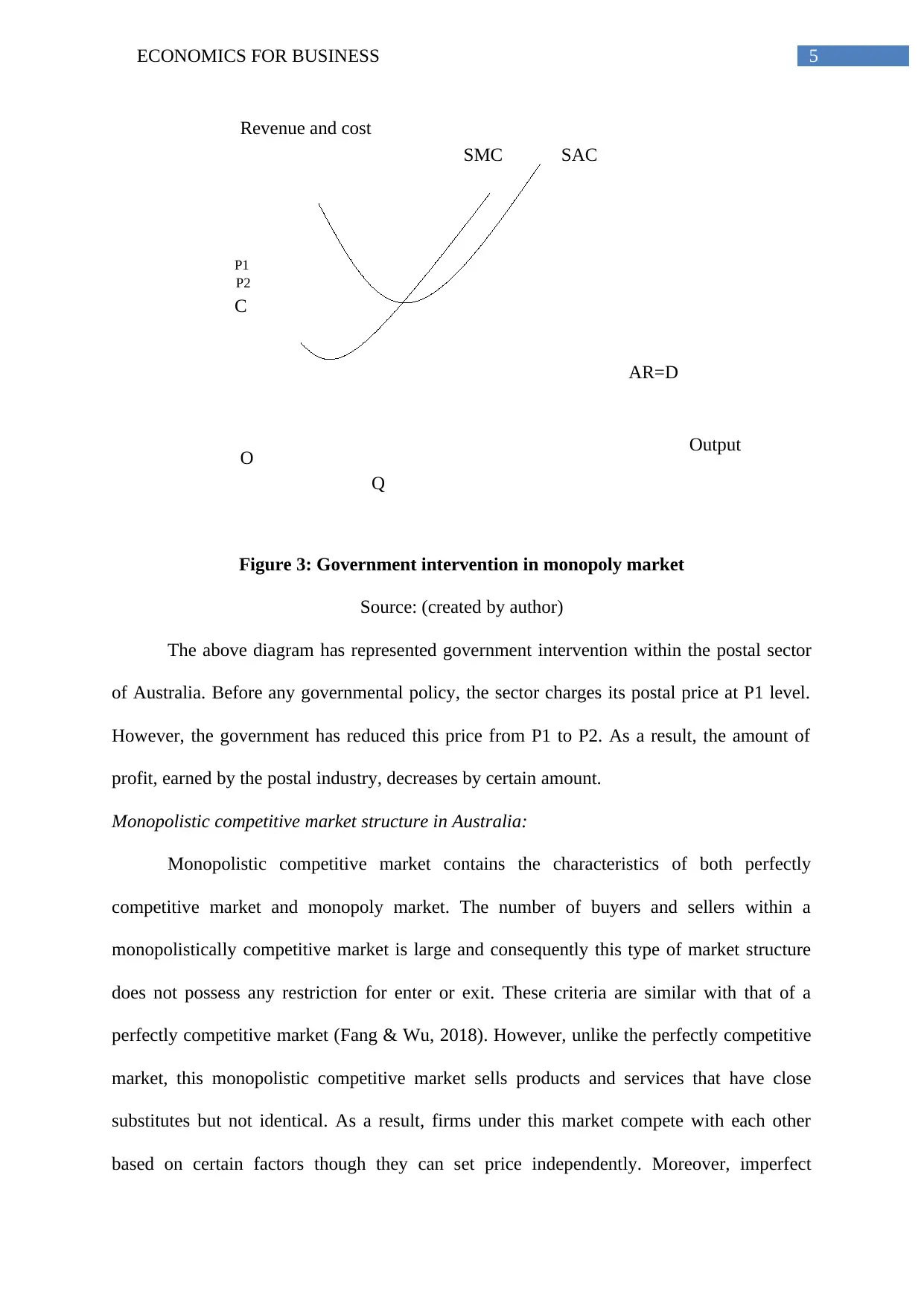
5ECONOMICS FOR BUSINESS
P1
Revenue and cost
Output
O
Q
SACSMC
AR=D
C
P2
Figure 3: Government intervention in monopoly market
Source: (created by author)
The above diagram has represented government intervention within the postal sector
of Australia. Before any governmental policy, the sector charges its postal price at P1 level.
However, the government has reduced this price from P1 to P2. As a result, the amount of
profit, earned by the postal industry, decreases by certain amount.
Monopolistic competitive market structure in Australia:
Monopolistic competitive market contains the characteristics of both perfectly
competitive market and monopoly market. The number of buyers and sellers within a
monopolistically competitive market is large and consequently this type of market structure
does not possess any restriction for enter or exit. These criteria are similar with that of a
perfectly competitive market (Fang & Wu, 2018). However, unlike the perfectly competitive
market, this monopolistic competitive market sells products and services that have close
substitutes but not identical. As a result, firms under this market compete with each other
based on certain factors though they can set price independently. Moreover, imperfect
P1
Revenue and cost
Output
O
Q
SACSMC
AR=D
C
P2
Figure 3: Government intervention in monopoly market
Source: (created by author)
The above diagram has represented government intervention within the postal sector
of Australia. Before any governmental policy, the sector charges its postal price at P1 level.
However, the government has reduced this price from P1 to P2. As a result, the amount of
profit, earned by the postal industry, decreases by certain amount.
Monopolistic competitive market structure in Australia:
Monopolistic competitive market contains the characteristics of both perfectly
competitive market and monopoly market. The number of buyers and sellers within a
monopolistically competitive market is large and consequently this type of market structure
does not possess any restriction for enter or exit. These criteria are similar with that of a
perfectly competitive market (Fang & Wu, 2018). However, unlike the perfectly competitive
market, this monopolistic competitive market sells products and services that have close
substitutes but not identical. As a result, firms under this market compete with each other
based on certain factors though they can set price independently. Moreover, imperfect
⊘ This is a preview!⊘
Do you want full access?
Subscribe today to unlock all pages.

Trusted by 1+ million students worldwide
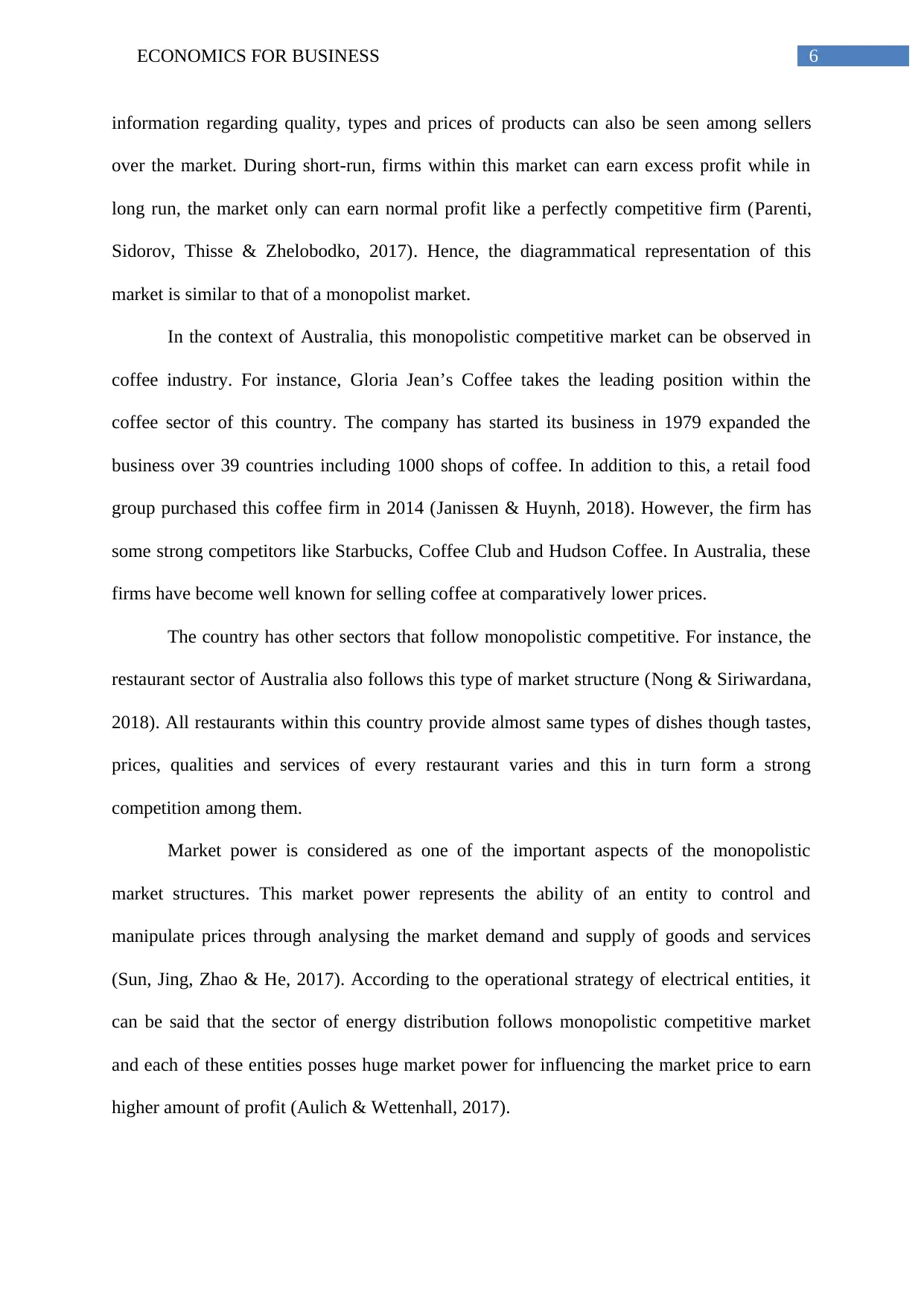
6ECONOMICS FOR BUSINESS
information regarding quality, types and prices of products can also be seen among sellers
over the market. During short-run, firms within this market can earn excess profit while in
long run, the market only can earn normal profit like a perfectly competitive firm (Parenti,
Sidorov, Thisse & Zhelobodko, 2017). Hence, the diagrammatical representation of this
market is similar to that of a monopolist market.
In the context of Australia, this monopolistic competitive market can be observed in
coffee industry. For instance, Gloria Jean’s Coffee takes the leading position within the
coffee sector of this country. The company has started its business in 1979 expanded the
business over 39 countries including 1000 shops of coffee. In addition to this, a retail food
group purchased this coffee firm in 2014 (Janissen & Huynh, 2018). However, the firm has
some strong competitors like Starbucks, Coffee Club and Hudson Coffee. In Australia, these
firms have become well known for selling coffee at comparatively lower prices.
The country has other sectors that follow monopolistic competitive. For instance, the
restaurant sector of Australia also follows this type of market structure (Nong & Siriwardana,
2018). All restaurants within this country provide almost same types of dishes though tastes,
prices, qualities and services of every restaurant varies and this in turn form a strong
competition among them.
Market power is considered as one of the important aspects of the monopolistic
market structures. This market power represents the ability of an entity to control and
manipulate prices through analysing the market demand and supply of goods and services
(Sun, Jing, Zhao & He, 2017). According to the operational strategy of electrical entities, it
can be said that the sector of energy distribution follows monopolistic competitive market
and each of these entities posses huge market power for influencing the market price to earn
higher amount of profit (Aulich & Wettenhall, 2017).
information regarding quality, types and prices of products can also be seen among sellers
over the market. During short-run, firms within this market can earn excess profit while in
long run, the market only can earn normal profit like a perfectly competitive firm (Parenti,
Sidorov, Thisse & Zhelobodko, 2017). Hence, the diagrammatical representation of this
market is similar to that of a monopolist market.
In the context of Australia, this monopolistic competitive market can be observed in
coffee industry. For instance, Gloria Jean’s Coffee takes the leading position within the
coffee sector of this country. The company has started its business in 1979 expanded the
business over 39 countries including 1000 shops of coffee. In addition to this, a retail food
group purchased this coffee firm in 2014 (Janissen & Huynh, 2018). However, the firm has
some strong competitors like Starbucks, Coffee Club and Hudson Coffee. In Australia, these
firms have become well known for selling coffee at comparatively lower prices.
The country has other sectors that follow monopolistic competitive. For instance, the
restaurant sector of Australia also follows this type of market structure (Nong & Siriwardana,
2018). All restaurants within this country provide almost same types of dishes though tastes,
prices, qualities and services of every restaurant varies and this in turn form a strong
competition among them.
Market power is considered as one of the important aspects of the monopolistic
market structures. This market power represents the ability of an entity to control and
manipulate prices through analysing the market demand and supply of goods and services
(Sun, Jing, Zhao & He, 2017). According to the operational strategy of electrical entities, it
can be said that the sector of energy distribution follows monopolistic competitive market
and each of these entities posses huge market power for influencing the market price to earn
higher amount of profit (Aulich & Wettenhall, 2017).
Paraphrase This Document
Need a fresh take? Get an instant paraphrase of this document with our AI Paraphraser
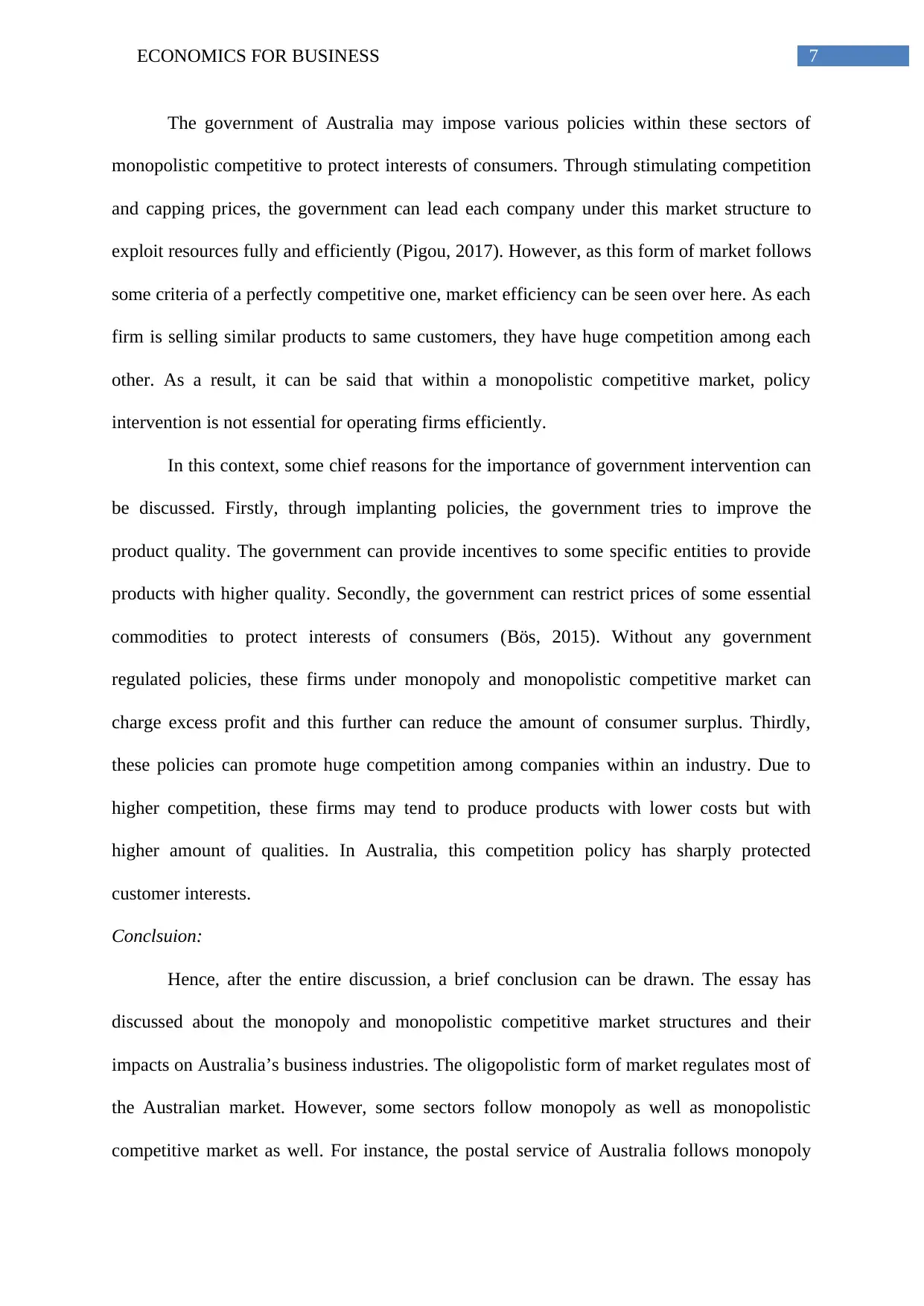
7ECONOMICS FOR BUSINESS
The government of Australia may impose various policies within these sectors of
monopolistic competitive to protect interests of consumers. Through stimulating competition
and capping prices, the government can lead each company under this market structure to
exploit resources fully and efficiently (Pigou, 2017). However, as this form of market follows
some criteria of a perfectly competitive one, market efficiency can be seen over here. As each
firm is selling similar products to same customers, they have huge competition among each
other. As a result, it can be said that within a monopolistic competitive market, policy
intervention is not essential for operating firms efficiently.
In this context, some chief reasons for the importance of government intervention can
be discussed. Firstly, through implanting policies, the government tries to improve the
product quality. The government can provide incentives to some specific entities to provide
products with higher quality. Secondly, the government can restrict prices of some essential
commodities to protect interests of consumers (Bös, 2015). Without any government
regulated policies, these firms under monopoly and monopolistic competitive market can
charge excess profit and this further can reduce the amount of consumer surplus. Thirdly,
these policies can promote huge competition among companies within an industry. Due to
higher competition, these firms may tend to produce products with lower costs but with
higher amount of qualities. In Australia, this competition policy has sharply protected
customer interests.
Conclsuion:
Hence, after the entire discussion, a brief conclusion can be drawn. The essay has
discussed about the monopoly and monopolistic competitive market structures and their
impacts on Australia’s business industries. The oligopolistic form of market regulates most of
the Australian market. However, some sectors follow monopoly as well as monopolistic
competitive market as well. For instance, the postal service of Australia follows monopoly
The government of Australia may impose various policies within these sectors of
monopolistic competitive to protect interests of consumers. Through stimulating competition
and capping prices, the government can lead each company under this market structure to
exploit resources fully and efficiently (Pigou, 2017). However, as this form of market follows
some criteria of a perfectly competitive one, market efficiency can be seen over here. As each
firm is selling similar products to same customers, they have huge competition among each
other. As a result, it can be said that within a monopolistic competitive market, policy
intervention is not essential for operating firms efficiently.
In this context, some chief reasons for the importance of government intervention can
be discussed. Firstly, through implanting policies, the government tries to improve the
product quality. The government can provide incentives to some specific entities to provide
products with higher quality. Secondly, the government can restrict prices of some essential
commodities to protect interests of consumers (Bös, 2015). Without any government
regulated policies, these firms under monopoly and monopolistic competitive market can
charge excess profit and this further can reduce the amount of consumer surplus. Thirdly,
these policies can promote huge competition among companies within an industry. Due to
higher competition, these firms may tend to produce products with lower costs but with
higher amount of qualities. In Australia, this competition policy has sharply protected
customer interests.
Conclsuion:
Hence, after the entire discussion, a brief conclusion can be drawn. The essay has
discussed about the monopoly and monopolistic competitive market structures and their
impacts on Australia’s business industries. The oligopolistic form of market regulates most of
the Australian market. However, some sectors follow monopoly as well as monopolistic
competitive market as well. For instance, the postal service of Australia follows monopoly
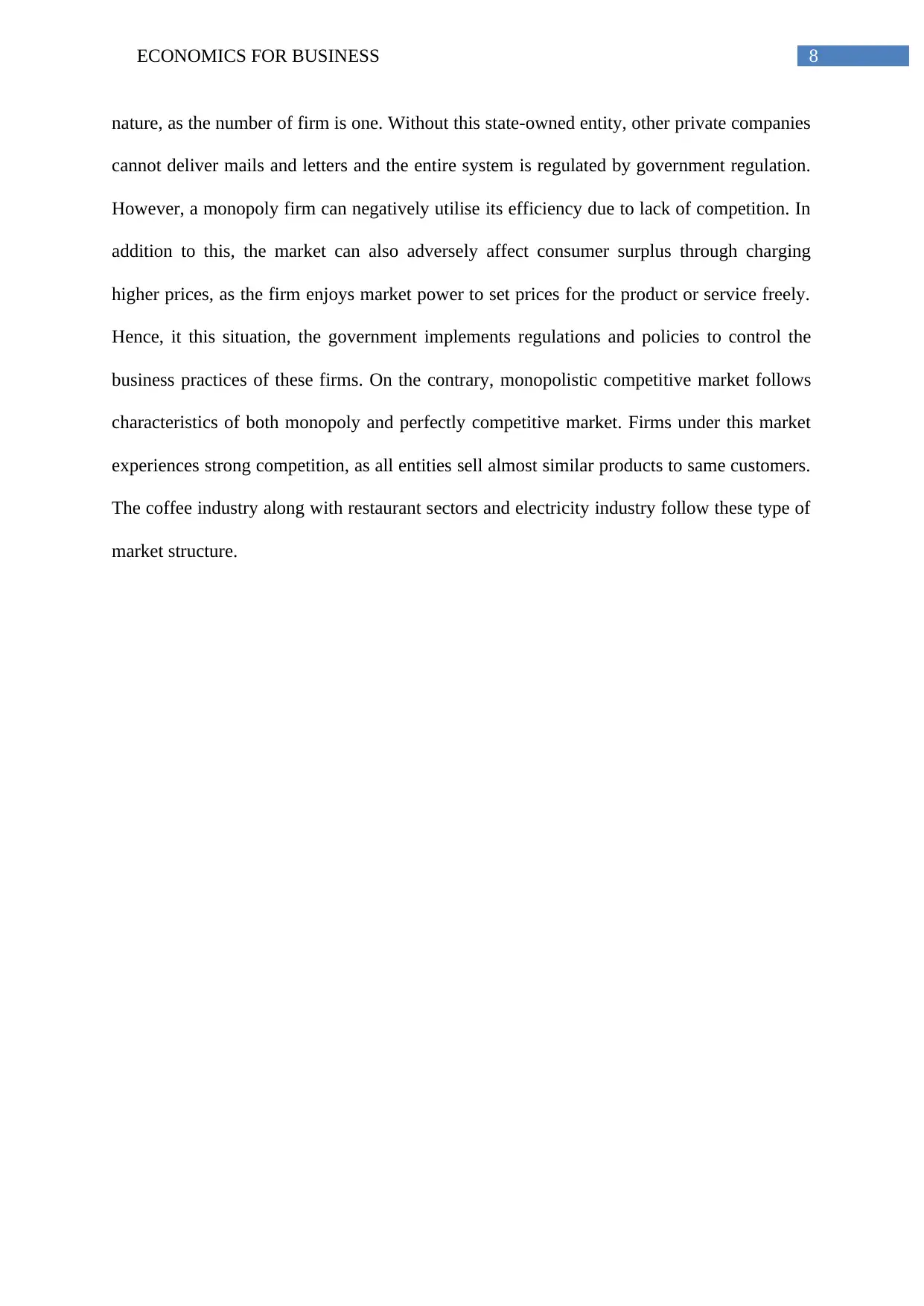
8ECONOMICS FOR BUSINESS
nature, as the number of firm is one. Without this state-owned entity, other private companies
cannot deliver mails and letters and the entire system is regulated by government regulation.
However, a monopoly firm can negatively utilise its efficiency due to lack of competition. In
addition to this, the market can also adversely affect consumer surplus through charging
higher prices, as the firm enjoys market power to set prices for the product or service freely.
Hence, it this situation, the government implements regulations and policies to control the
business practices of these firms. On the contrary, monopolistic competitive market follows
characteristics of both monopoly and perfectly competitive market. Firms under this market
experiences strong competition, as all entities sell almost similar products to same customers.
The coffee industry along with restaurant sectors and electricity industry follow these type of
market structure.
nature, as the number of firm is one. Without this state-owned entity, other private companies
cannot deliver mails and letters and the entire system is regulated by government regulation.
However, a monopoly firm can negatively utilise its efficiency due to lack of competition. In
addition to this, the market can also adversely affect consumer surplus through charging
higher prices, as the firm enjoys market power to set prices for the product or service freely.
Hence, it this situation, the government implements regulations and policies to control the
business practices of these firms. On the contrary, monopolistic competitive market follows
characteristics of both monopoly and perfectly competitive market. Firms under this market
experiences strong competition, as all entities sell almost similar products to same customers.
The coffee industry along with restaurant sectors and electricity industry follow these type of
market structure.
⊘ This is a preview!⊘
Do you want full access?
Subscribe today to unlock all pages.

Trusted by 1+ million students worldwide
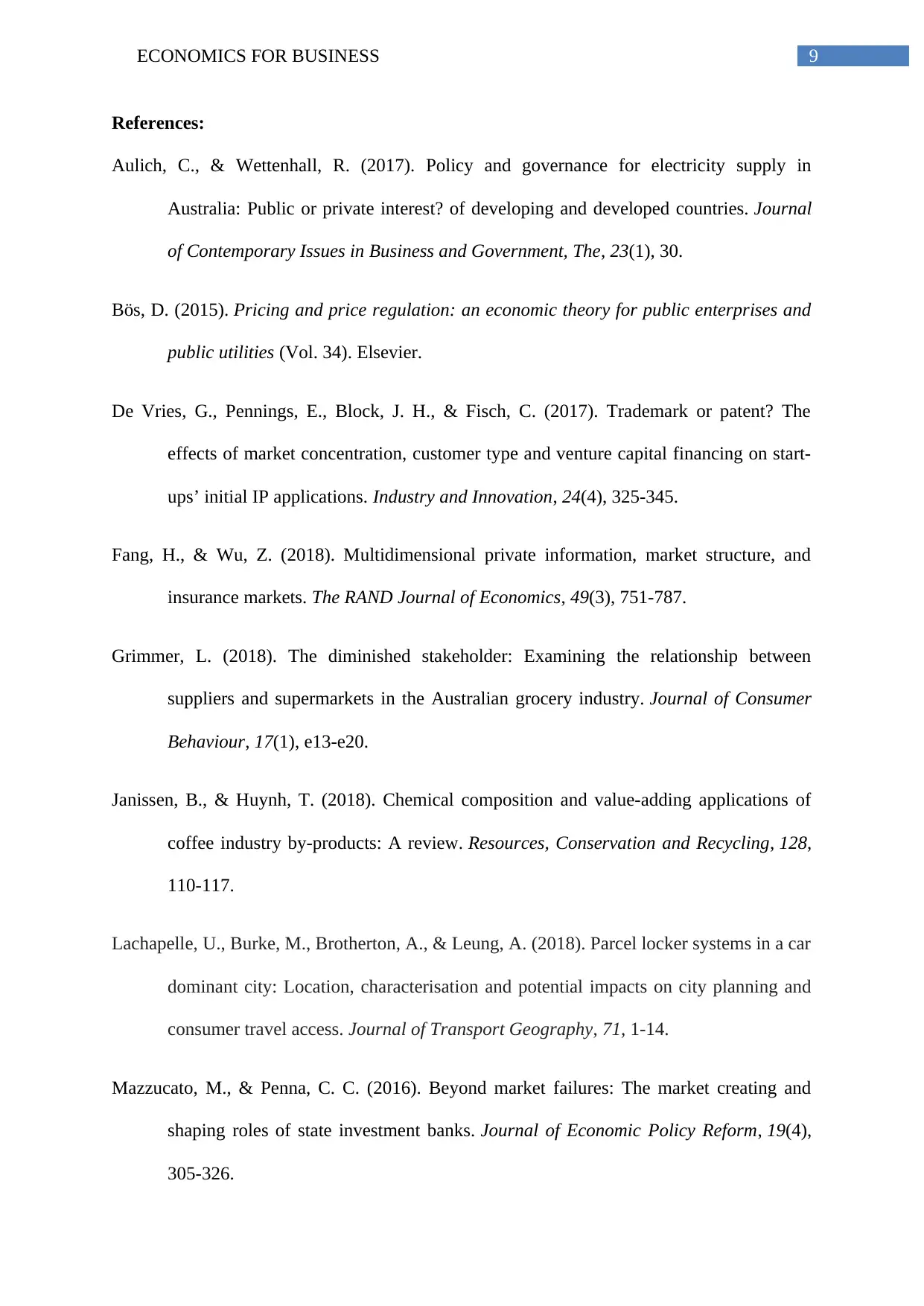
9ECONOMICS FOR BUSINESS
References:
Aulich, C., & Wettenhall, R. (2017). Policy and governance for electricity supply in
Australia: Public or private interest? of developing and developed countries. Journal
of Contemporary Issues in Business and Government, The, 23(1), 30.
Bös, D. (2015). Pricing and price regulation: an economic theory for public enterprises and
public utilities (Vol. 34). Elsevier.
De Vries, G., Pennings, E., Block, J. H., & Fisch, C. (2017). Trademark or patent? The
effects of market concentration, customer type and venture capital financing on start-
ups’ initial IP applications. Industry and Innovation, 24(4), 325-345.
Fang, H., & Wu, Z. (2018). Multidimensional private information, market structure, and
insurance markets. The RAND Journal of Economics, 49(3), 751-787.
Grimmer, L. (2018). The diminished stakeholder: Examining the relationship between
suppliers and supermarkets in the Australian grocery industry. Journal of Consumer
Behaviour, 17(1), e13-e20.
Janissen, B., & Huynh, T. (2018). Chemical composition and value-adding applications of
coffee industry by-products: A review. Resources, Conservation and Recycling, 128,
110-117.
Lachapelle, U., Burke, M., Brotherton, A., & Leung, A. (2018). Parcel locker systems in a car
dominant city: Location, characterisation and potential impacts on city planning and
consumer travel access. Journal of Transport Geography, 71, 1-14.
Mazzucato, M., & Penna, C. C. (2016). Beyond market failures: The market creating and
shaping roles of state investment banks. Journal of Economic Policy Reform, 19(4),
305-326.
References:
Aulich, C., & Wettenhall, R. (2017). Policy and governance for electricity supply in
Australia: Public or private interest? of developing and developed countries. Journal
of Contemporary Issues in Business and Government, The, 23(1), 30.
Bös, D. (2015). Pricing and price regulation: an economic theory for public enterprises and
public utilities (Vol. 34). Elsevier.
De Vries, G., Pennings, E., Block, J. H., & Fisch, C. (2017). Trademark or patent? The
effects of market concentration, customer type and venture capital financing on start-
ups’ initial IP applications. Industry and Innovation, 24(4), 325-345.
Fang, H., & Wu, Z. (2018). Multidimensional private information, market structure, and
insurance markets. The RAND Journal of Economics, 49(3), 751-787.
Grimmer, L. (2018). The diminished stakeholder: Examining the relationship between
suppliers and supermarkets in the Australian grocery industry. Journal of Consumer
Behaviour, 17(1), e13-e20.
Janissen, B., & Huynh, T. (2018). Chemical composition and value-adding applications of
coffee industry by-products: A review. Resources, Conservation and Recycling, 128,
110-117.
Lachapelle, U., Burke, M., Brotherton, A., & Leung, A. (2018). Parcel locker systems in a car
dominant city: Location, characterisation and potential impacts on city planning and
consumer travel access. Journal of Transport Geography, 71, 1-14.
Mazzucato, M., & Penna, C. C. (2016). Beyond market failures: The market creating and
shaping roles of state investment banks. Journal of Economic Policy Reform, 19(4),
305-326.
Paraphrase This Document
Need a fresh take? Get an instant paraphrase of this document with our AI Paraphraser
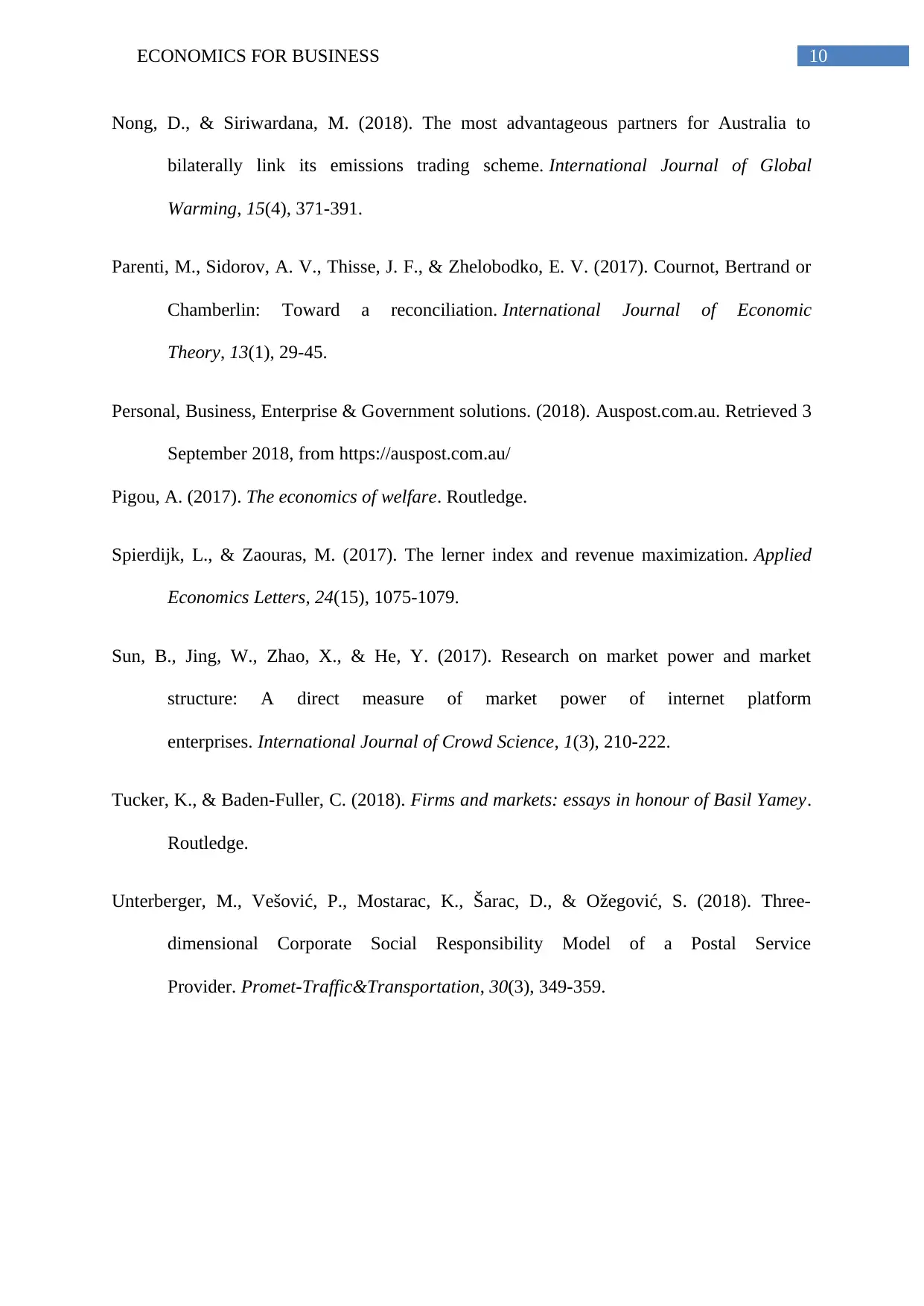
10ECONOMICS FOR BUSINESS
Nong, D., & Siriwardana, M. (2018). The most advantageous partners for Australia to
bilaterally link its emissions trading scheme. International Journal of Global
Warming, 15(4), 371-391.
Parenti, M., Sidorov, A. V., Thisse, J. F., & Zhelobodko, E. V. (2017). Cournot, Bertrand or
Chamberlin: Toward a reconciliation. International Journal of Economic
Theory, 13(1), 29-45.
Personal, Business, Enterprise & Government solutions. (2018). Auspost.com.au. Retrieved 3
September 2018, from https://auspost.com.au/
Pigou, A. (2017). The economics of welfare. Routledge.
Spierdijk, L., & Zaouras, M. (2017). The lerner index and revenue maximization. Applied
Economics Letters, 24(15), 1075-1079.
Sun, B., Jing, W., Zhao, X., & He, Y. (2017). Research on market power and market
structure: A direct measure of market power of internet platform
enterprises. International Journal of Crowd Science, 1(3), 210-222.
Tucker, K., & Baden-Fuller, C. (2018). Firms and markets: essays in honour of Basil Yamey.
Routledge.
Unterberger, M., Vešović, P., Mostarac, K., Šarac, D., & Ožegović, S. (2018). Three-
dimensional Corporate Social Responsibility Model of a Postal Service
Provider. Promet-Traffic&Transportation, 30(3), 349-359.
Nong, D., & Siriwardana, M. (2018). The most advantageous partners for Australia to
bilaterally link its emissions trading scheme. International Journal of Global
Warming, 15(4), 371-391.
Parenti, M., Sidorov, A. V., Thisse, J. F., & Zhelobodko, E. V. (2017). Cournot, Bertrand or
Chamberlin: Toward a reconciliation. International Journal of Economic
Theory, 13(1), 29-45.
Personal, Business, Enterprise & Government solutions. (2018). Auspost.com.au. Retrieved 3
September 2018, from https://auspost.com.au/
Pigou, A. (2017). The economics of welfare. Routledge.
Spierdijk, L., & Zaouras, M. (2017). The lerner index and revenue maximization. Applied
Economics Letters, 24(15), 1075-1079.
Sun, B., Jing, W., Zhao, X., & He, Y. (2017). Research on market power and market
structure: A direct measure of market power of internet platform
enterprises. International Journal of Crowd Science, 1(3), 210-222.
Tucker, K., & Baden-Fuller, C. (2018). Firms and markets: essays in honour of Basil Yamey.
Routledge.
Unterberger, M., Vešović, P., Mostarac, K., Šarac, D., & Ožegović, S. (2018). Three-
dimensional Corporate Social Responsibility Model of a Postal Service
Provider. Promet-Traffic&Transportation, 30(3), 349-359.
1 out of 11
Related Documents
Your All-in-One AI-Powered Toolkit for Academic Success.
+13062052269
info@desklib.com
Available 24*7 on WhatsApp / Email
![[object Object]](/_next/static/media/star-bottom.7253800d.svg)
Unlock your academic potential
Copyright © 2020–2025 A2Z Services. All Rights Reserved. Developed and managed by ZUCOL.



